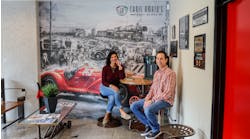It all started with a business plan sketched on a napkin. Michael Quinn and Patrick O’Neill took a leap of faith when they opened their first collision repair shop in August 1998. The business partners were from opposite sides of the country and had never run their own shop before, but they had big plans.
When the idea came to them to open a collision repair shop, Quinn was living in Philadelphia. “That’s where I cut my teeth in the business,” he says. He trained as a mechanic and eventually became an ASE certified master technician and an I-CAR volunteer. Meanwhile, O’Neill was living in Bakersfield, Calif., where he ran a production paint facility and then, after completing his M.B.A, worked as a small business advisor helping minority companies write business proposals. The two met while working for a consulting company based in Sedona, Ariz. “We fell in love with Arizona and decided to start a business here,” Quinn says. After an initial meeting where they sketched out tentative plans on a napkin, they began collaborating on a business plan from their respective states. “We did a lot of stuff on 14.4 modems,” he says. “This was back in ’95.”
At the time the East Coast was experiencing negative growth, and they both saw a window of opportunity in Tucson, an emerging market. “Our goal was to bring a high level of service in repairs to the market,” Quinn explains. It didn’t hurt that both found Tucson “a beautiful place to live.”
The first hurdle was coming up with a name for their business. The initial location they considered was a vacated fire station, so they came up with the name “911 Collision Centers.” They went so far as to clear the name with local police and emergency personnel to make sure they wouldn’t be in violation. They even toyed with adopting a Dalmatian as a mascot. The location didn’t pan out, but the name stuck. And from the start they had larger ambitions—they settled on the plural “centers” because they knew they wanted to open at least a second location. Today, there are four 911 Collision Centers throughout the Tucson area, with the fifth set to open this month on the far east side of town. “Today we hope to be a regional multi-shop operator,” Quinn says. “I don’t know that we’ll ever achieve nationwide.”
Quinn and O’Neill have cleared several hurdles, and the race isn’t over yet as they continue to build their business. The first obstacle was simple but hard to surmount: they were having trouble attracting customers. “You know the expression from ‘Field of Dreams’—build it and they will come?” Quinn asked. “They didn’t come. They had existing relationships. It took a long time for us to build trust with insurers. That’s one of the things we didn’t anticipate in the business plan because we were both new to the market.”
So they started an aggressive marketing campaign to drive customers to their door. They also worked on establishing solid relationships with insurers. With that in mind, they came up with a set of founding principles: to address the needs of four stakeholders—partners, vendors, employees and the community—as well as to run an ethical business. The strategy paid off. “In 2001 we were honored by the Better Business Bureau for ethical business practices,” Quinn says. “That was a tremendous boon for our business.” They also got involved with the local community, adopting the local Ronald McDonald House’s vehicle and taking over its monthly cleaning and maintenance.
The first 911 Collision Center opened near the University of Arizona with 8,000 sq. ft. (it has since grown to 20,000 sq. ft). Eighteen months after opening the first location, they opened a second, 7,000-sq.-ft shop near Interstate 10. Then, in 2003, an opportunity came to takeover the body shop at a Mitsubishi dealership on the east side, and they took it. The facility was already well equipped and had a built-in customer base. The fourth location came quickly after that on the north side of town.
“Instead of building one super megabox, we thought it was more important to have coverage in all parts of the market,” Quinn says. “People don’t want to drive 25 miles to have their cars fixed, so we knew it was important to open a few facilities out and get a footprint in the area.”
In addition to slow, steady growth in the local market, another successful component of 911 Collision Centers is a staff that understands and upholds the founding principles. Sounding a bit unorthodox, Quinn says he hires employees for their ability to sign on to the company’s culture rather than for their ability to repair an automobile. “We hire on attitude, not necessarily skill set. We needed people who would make the right decisions,” he explains. “Did we find them all right away? No, we’ve had our challenges, but we’ve found that that is key.”
Quinn credits the shop’s success to staff who share the same values and commitment to customer service. “We documented our culture and we have a culture card that people carry around and keep in their pocket,” he adds. Staff members also are treated as stakeholders. Built into the payroll plan are bonuses for technicians based on customer satisfaction.
He also makes it a point to read every customer service survey that comes in each day—to make sure he’s meeting his customers’ needs. “There are people who tout customer service, but delivering customer satisfaction is another thing,” he says.


